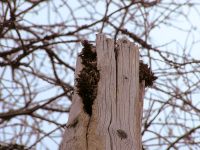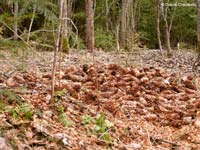Woodpeckers are forest birds. Their main food is insects living in wood and under bark of trees. The woodpecker reaches for insects with the help of its strong, pointed beak, which is used as a chisel, and also a long tongue. Having found a pass done by an insect, a woodpecker extends into it its tongue, which has sticky properties.
Its toes are adapted for climbing on vertical trunks of trees; for this purpose two toes are directed forward, and two — backward. Its tail serves as a support when a woodpecker sits on a trunk.
Woodpeckers sleep in hollows.
They perform courtship display by drumming by the beak on dry wood. For this purpose, they choose the most "sonorous" dry tree. But if a woodpecker lives near a human settlement — it may use for such "songs" an empty can or tin of water-drain.
All woodpeckers make nests in hollows, excavating them themselves.
Lesser spotted woodpecker
(Dendrocopos major)
In size, it is approximately like a large thrush. On the wings there is a big white stain; the back is black, the sides are white, on the head there is a red stain; the bottom of the tail is pink.
Besides insects-woodborers, it eats pine and fir-tree seeds. In the forest, it is possible to find so-called “smithies” of a woodpecker — stubs or old trunks in cracks of which a woodpecker fixes cones: It is more convenient to strip them so. (See the picture at the left).
Below a "smithy" on the ground, big heaps of developed cones are often formed. (The picture at the right).
In the spring, the great spotted woodpecker can drink birch sap, making on trunks accurate horizontal rows of holes in bark.
And in autumn, it eats with pleasure berries: bilberry, ashberry, cowberry, elder.
Its sonorous "kek-kek” can be heard in the forest any time of the year.
Black woodpecker
(Dryocopus martius)
It is a large (like a crow) black bird. Males have bright red top of the head; females have a nape of the same color.
Its voice in flight resembles modulating whistle. But having sat down, it — as if proudly announcing about this — cries: "I’ve sat! I’ve sat! " (with long sound "[e]").
The clutch is incubated by both parents; they are replacing each other every several hours. It is accompanied by complex ceremonial: the arrived bird gives to know about itself from outside by cries; the incubating bird responds from within by knocks. Only after that they replace each other.
Black woodpeckers sleep in hollows always, not only during brooding time. And each partner has its own "bedroom".
Excavated by black woodpeckers hollows become homes for many forest inhabitants: stock doves, titmice, starlings, sparrows, nuthatches, martens, squirrels, wasps, etc.
-1.jpg)


.jpg)